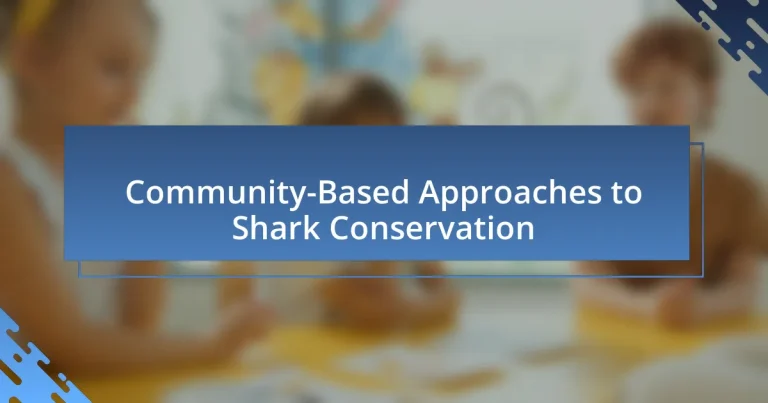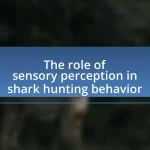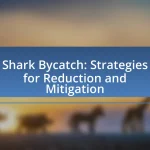Community-based approaches to shark conservation involve the active participation of local communities in the protection and management of shark populations and their habitats. These strategies emphasize local stewardship, sustainable fishing practices, and the integration of traditional ecological knowledge, leading to more effective conservation outcomes. The article explores the differences between community-based and traditional conservation methods, highlights successful initiatives, and discusses the challenges communities face, including economic pressures and lack of awareness. It also outlines best practices for implementing these approaches, the role of stakeholders, and the long-term benefits for local communities involved in shark conservation efforts.
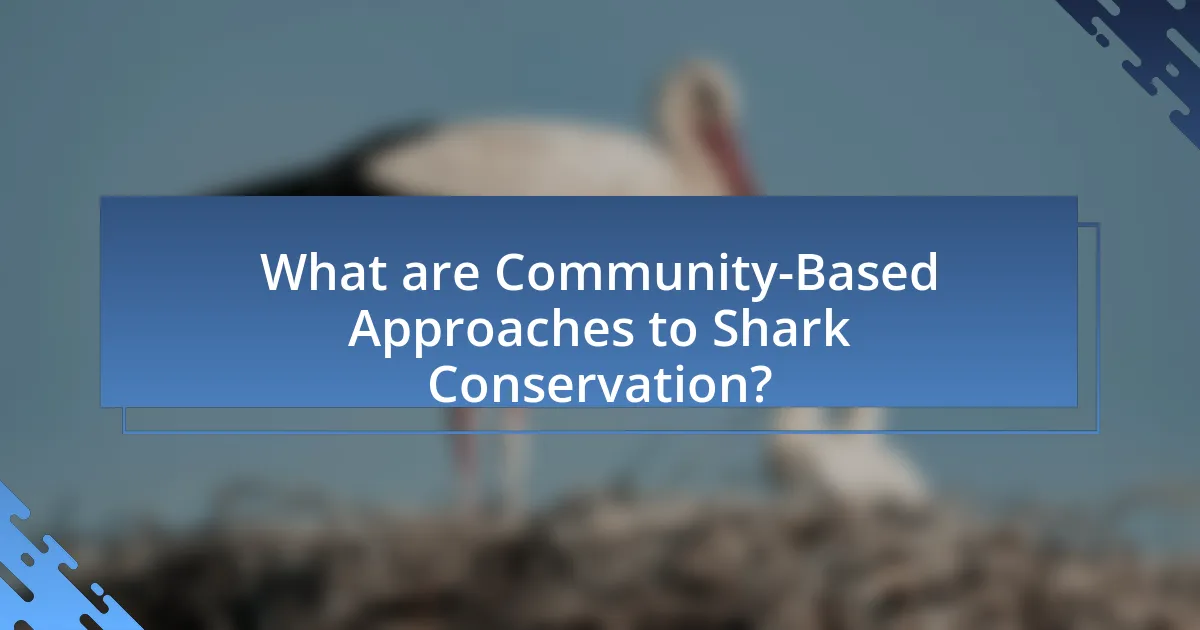
What are Community-Based Approaches to Shark Conservation?
Community-based approaches to shark conservation involve local communities actively participating in the protection and management of shark populations and their habitats. These approaches often include initiatives such as establishing marine protected areas, promoting sustainable fishing practices, and engaging in educational programs to raise awareness about the ecological importance of sharks. Evidence shows that when local communities are involved, conservation efforts are more effective; for instance, a study published in the journal “Conservation Biology” found that community-led management in the Philippines led to a significant increase in shark populations and biodiversity.
How do community-based approaches differ from traditional conservation methods?
Community-based approaches differ from traditional conservation methods by emphasizing local community involvement and stewardship in conservation efforts. Traditional methods often rely on top-down regulations and external management, which can overlook local knowledge and needs. In contrast, community-based approaches integrate local stakeholders in decision-making processes, fostering a sense of ownership and responsibility towards conservation. Research indicates that involving communities can lead to more effective and sustainable conservation outcomes, as seen in various case studies where local engagement has resulted in improved biodiversity and resource management.
What are the key principles of community-based conservation?
The key principles of community-based conservation include local community involvement, sustainable resource management, and the integration of traditional ecological knowledge. Local community involvement ensures that the people who are most affected by conservation efforts have a voice in decision-making processes, which enhances the effectiveness and sustainability of conservation initiatives. Sustainable resource management focuses on balancing ecological health with community needs, promoting practices that do not deplete resources. The integration of traditional ecological knowledge recognizes the value of indigenous practices and insights, which can lead to more effective conservation strategies. These principles are supported by various case studies demonstrating that successful conservation outcomes often arise when local communities are actively engaged and empowered in the management of their natural resources.
Why is community involvement crucial for shark conservation?
Community involvement is crucial for shark conservation because it fosters local stewardship and enhances the effectiveness of conservation efforts. Engaging communities in conservation initiatives leads to increased awareness of the ecological importance of sharks, which can result in more sustainable fishing practices and reduced shark hunting. Studies have shown that when local populations are involved in conservation, such as through community-managed marine areas, there is often a significant increase in shark populations. For instance, research published in the journal “Conservation Biology” indicates that community-led initiatives in places like the Bahamas have led to a 200% increase in shark abundance over a decade. This demonstrates that local engagement not only empowers communities but also directly contributes to the recovery and sustainability of shark populations.
What role do local communities play in shark conservation efforts?
Local communities play a crucial role in shark conservation efforts by actively participating in sustainable practices and advocating for protective measures. These communities often rely on marine resources for their livelihoods, which motivates them to engage in conservation initiatives that ensure the long-term health of shark populations. For instance, community-led programs in places like the Bahamas have successfully implemented no-take zones, resulting in increased shark populations and enhanced local fisheries. Research indicates that when local communities are involved in conservation, compliance with regulations improves, leading to more effective protection of shark species.
How can local knowledge contribute to effective conservation strategies?
Local knowledge significantly enhances effective conservation strategies by providing insights into species behavior, habitat use, and ecosystem dynamics. This knowledge, often accumulated over generations, allows conservationists to tailor strategies that are culturally relevant and ecologically sound. For instance, studies have shown that local fishers possess detailed understanding of shark migration patterns and breeding sites, which can inform targeted conservation efforts. Research published in the journal “Conservation Biology” highlights that integrating local ecological knowledge with scientific data leads to more successful management outcomes, as it fosters community engagement and compliance with conservation measures.
What are examples of successful community-led shark conservation initiatives?
Successful community-led shark conservation initiatives include the “Shark Guardians” program in Indonesia, which empowers local fishermen to protect shark populations through sustainable fishing practices and education. This initiative has led to a significant reduction in shark catch rates and increased awareness about the ecological importance of sharks. Another example is the “Shark Sanctuary” established in the Bahamas, where local communities have collaborated with government agencies to create a no-fishing zone for sharks, resulting in a resurgence of shark populations and enhanced marine biodiversity. These initiatives demonstrate the effectiveness of community involvement in shark conservation efforts, supported by data showing increased shark sightings and healthier marine ecosystems in these areas.
What challenges do communities face in shark conservation?
Communities face several challenges in shark conservation, primarily including economic dependence on fishing, lack of awareness, and insufficient regulatory frameworks. Economic dependence on fishing often leads to overfishing and unsustainable practices, as local livelihoods rely heavily on shark catches. For instance, in many coastal regions, sharks are targeted for their fins, which are highly valued in international markets, creating a conflict between conservation efforts and economic needs.
Additionally, a lack of awareness about the ecological importance of sharks contributes to their decline; many community members may not understand the role sharks play in maintaining healthy marine ecosystems. This knowledge gap can hinder community support for conservation initiatives. Furthermore, insufficient regulatory frameworks often result in weak enforcement of existing laws, allowing illegal fishing and trade to persist. According to the Food and Agriculture Organization, many countries lack comprehensive management plans for shark populations, exacerbating the challenges faced by communities engaged in conservation efforts.
How do economic pressures impact community conservation efforts?
Economic pressures significantly hinder community conservation efforts by diverting resources and attention away from sustainable practices. When communities face financial strain, they often prioritize immediate economic needs, such as fishing for income, over long-term conservation goals. For instance, a study published in the journal “Conservation Biology” found that communities reliant on fishing are more likely to overexploit shark populations when economic conditions are poor, as they seek short-term financial relief. This shift can lead to a decline in biodiversity and disrupt marine ecosystems, ultimately undermining the very resources that communities depend on for their livelihoods.
What social factors influence community participation in conservation?
Social factors that influence community participation in conservation include social norms, community leadership, education levels, and economic incentives. Social norms shape individual behaviors and collective actions, encouraging participation when conservation is viewed positively within the community. Effective community leadership fosters trust and mobilizes resources, enhancing engagement in conservation efforts. Higher education levels correlate with increased awareness of environmental issues, leading to greater involvement in conservation activities. Economic incentives, such as sustainable fishing practices or ecotourism, provide tangible benefits that motivate communities to participate in conservation initiatives. These factors collectively enhance community involvement in conservation efforts, as evidenced by studies showing that communities with strong social networks and leadership are more successful in implementing conservation strategies.
How can community-based approaches be supported and enhanced?
Community-based approaches can be supported and enhanced through the establishment of collaborative partnerships between local communities, conservation organizations, and government agencies. These partnerships facilitate resource sharing, knowledge exchange, and capacity building, which are essential for effective shark conservation. For instance, the Shark Conservation Fund has demonstrated that engaging local fishers in sustainable practices leads to improved shark populations and community livelihoods, as evidenced by the successful implementation of community-managed marine protected areas in various regions.
What funding opportunities exist for community-led conservation projects?
Funding opportunities for community-led conservation projects include grants from governmental agencies, non-profit organizations, and international bodies. For instance, the Global Environment Facility provides financial support for projects that promote biodiversity conservation, including community-led initiatives. Additionally, the United Nations Development Programme offers funding through its Small Grants Programme, which specifically targets community-based projects that address environmental challenges. Furthermore, private foundations such as the Packard Foundation and the Moore Foundation also allocate resources for grassroots conservation efforts. These funding sources are crucial for empowering local communities to implement sustainable practices and protect marine ecosystems, including shark populations.
How can education and awareness programs strengthen community involvement?
Education and awareness programs can strengthen community involvement by providing essential knowledge about shark conservation and fostering a sense of responsibility among community members. These programs educate individuals on the ecological importance of sharks, the threats they face, and the benefits of their conservation, leading to increased public engagement in protective measures. For instance, a study by the Pew Charitable Trusts found that communities with educational initiatives on marine conservation saw a 30% increase in local participation in conservation activities. This demonstrates that informed communities are more likely to take action, advocate for sustainable practices, and collaborate with conservation organizations, ultimately enhancing the effectiveness of shark conservation efforts.
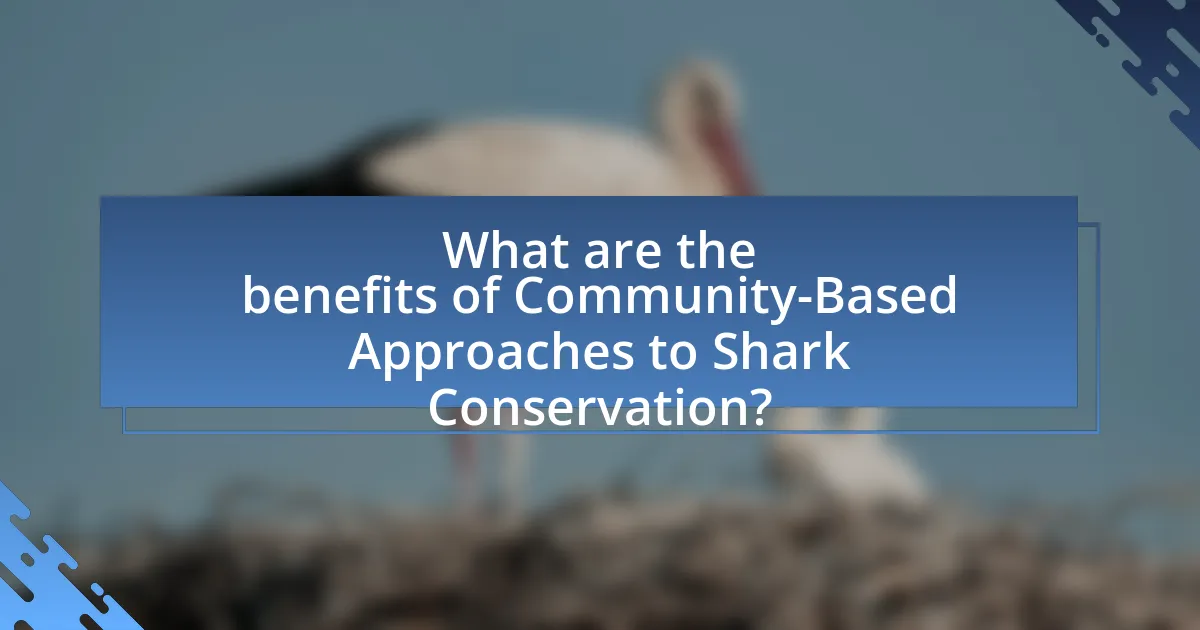
What are the benefits of Community-Based Approaches to Shark Conservation?
Community-based approaches to shark conservation enhance local engagement and stewardship, leading to more effective protection of shark populations. These approaches empower communities to take an active role in conservation efforts, fostering a sense of ownership and responsibility towards marine ecosystems. Research indicates that when local communities are involved, compliance with conservation measures increases, as seen in the case of the Bahamas, where community-led initiatives resulted in a significant recovery of shark populations. Additionally, community-based strategies often incorporate traditional ecological knowledge, which can improve conservation outcomes by aligning practices with local environmental conditions.
How do these approaches contribute to biodiversity preservation?
Community-based approaches to shark conservation significantly contribute to biodiversity preservation by fostering local stewardship and sustainable practices. These approaches empower communities to manage shark populations and their habitats, leading to healthier marine ecosystems. For instance, when local fishers engage in conservation efforts, they often adopt sustainable fishing techniques that reduce bycatch and habitat destruction, directly benefiting shark populations and the overall biodiversity of marine life. Research indicates that areas with community-led conservation initiatives, such as the establishment of marine protected areas, show increased shark abundance and diversity, which is crucial for maintaining ecological balance.
What impact do community-led initiatives have on shark populations?
Community-led initiatives positively impact shark populations by promoting sustainable fishing practices and habitat protection. These initiatives often involve local stakeholders in conservation efforts, leading to increased awareness and reduced overfishing. For instance, a study published in the journal “Conservation Biology” found that community-managed marine protected areas in the Philippines resulted in a 50% increase in shark abundance over five years. This demonstrates that when communities actively participate in conservation, they can effectively enhance shark populations and contribute to marine biodiversity.
How do community-based approaches promote sustainable fishing practices?
Community-based approaches promote sustainable fishing practices by empowering local communities to manage their own fisheries, leading to better resource stewardship. These approaches often involve the establishment of local governance systems that incorporate traditional ecological knowledge, which has been shown to enhance compliance with sustainable practices. For instance, a study published in the journal “Conservation Biology” found that communities engaged in co-management of fisheries reported a 30% increase in fish stocks over five years compared to areas without such management. This evidence illustrates that when communities take an active role in managing their resources, they are more likely to adopt practices that ensure long-term sustainability.
What social and economic benefits arise from community-based conservation?
Community-based conservation provides significant social and economic benefits, including enhanced local livelihoods and improved community cohesion. By involving local communities in conservation efforts, such initiatives often lead to sustainable income sources through eco-tourism and sustainable fishing practices, which can increase household incomes. For instance, a study by the World Resources Institute found that community-managed marine areas can yield up to 50% more fish biomass compared to areas without local management, directly benefiting local fishers. Additionally, these conservation efforts foster a sense of ownership and responsibility among community members, leading to stronger social ties and collective action towards environmental stewardship.
How can ecotourism be integrated into community conservation efforts?
Ecotourism can be integrated into community conservation efforts by creating sustainable economic opportunities that incentivize local communities to protect their natural resources. For instance, when communities develop ecotourism initiatives focused on shark conservation, they can attract visitors interested in marine biodiversity, which generates revenue that can be reinvested into conservation projects. A study by the World Wildlife Fund indicates that communities engaged in ecotourism can see a 20% increase in income, which directly correlates with enhanced conservation efforts. By involving local stakeholders in the management and promotion of ecotourism, communities can foster a sense of ownership and responsibility towards their marine ecosystems, leading to more effective conservation outcomes.
What are the long-term benefits for local communities involved in shark conservation?
Local communities involved in shark conservation experience long-term benefits such as enhanced biodiversity, sustainable fisheries, and increased ecotourism opportunities. By protecting shark populations, these communities help maintain healthy marine ecosystems, which are crucial for the overall balance of ocean life. Research indicates that healthy shark populations contribute to the stability of fish stocks, leading to more sustainable fishing practices and improved livelihoods for local fishers. Additionally, ecotourism related to shark diving and observation can provide significant economic benefits, with studies showing that shark-related tourism can generate millions in revenue for coastal communities, thereby fostering economic resilience and community development.
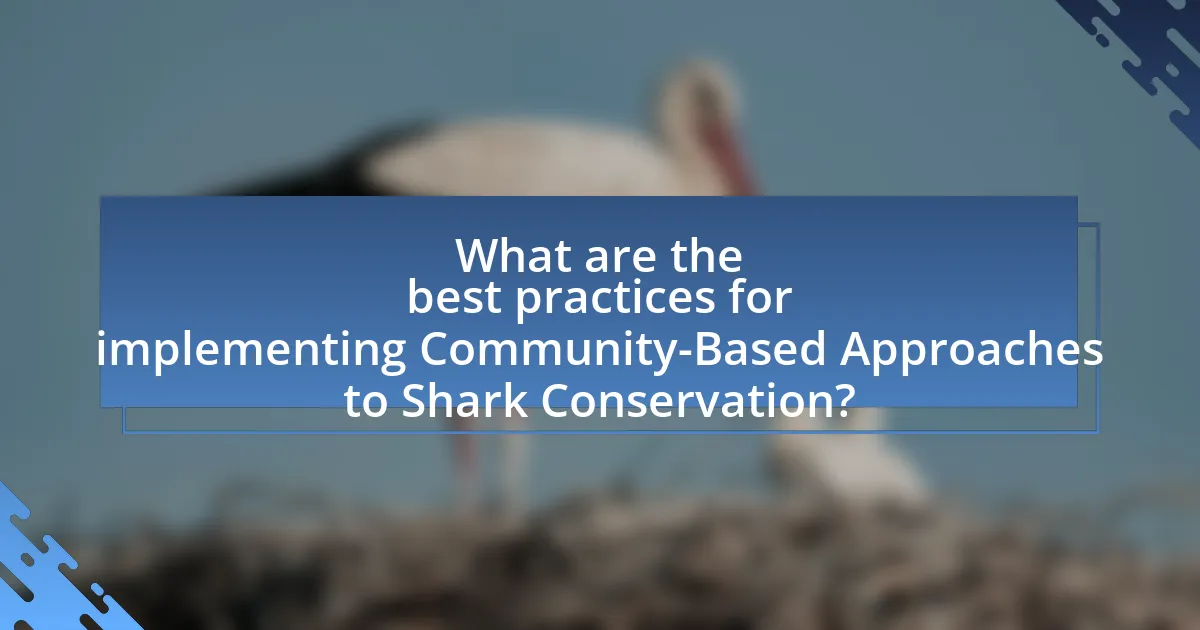
What are the best practices for implementing Community-Based Approaches to Shark Conservation?
The best practices for implementing Community-Based Approaches to Shark Conservation include engaging local communities in decision-making, promoting sustainable fishing practices, and providing education on the ecological importance of sharks. Engaging local communities ensures that conservation efforts are culturally relevant and supported by those directly affected. Promoting sustainable fishing practices helps reduce bycatch and overfishing, which are critical threats to shark populations. Education initiatives raise awareness about the role of sharks in marine ecosystems, fostering a sense of stewardship among community members. Research indicates that community-led conservation efforts can lead to improved outcomes for marine biodiversity, as seen in successful case studies from regions like the Caribbean and the Pacific Islands.
How can stakeholders collaborate effectively in conservation efforts?
Stakeholders can collaborate effectively in conservation efforts by establishing clear communication channels and shared goals. This collaboration can be enhanced through regular meetings, joint initiatives, and the use of technology for data sharing. For instance, community-based approaches to shark conservation have shown that involving local fishermen, conservationists, and government agencies in decision-making processes leads to more sustainable practices. Research indicates that when stakeholders actively participate in the management of marine resources, such as through co-management frameworks, the outcomes are more favorable for both biodiversity and local livelihoods.
What roles do NGOs and government agencies play in supporting communities?
NGOs and government agencies play crucial roles in supporting communities by providing resources, education, and advocacy for sustainable practices. NGOs often engage in grassroots initiatives that empower local populations through training and capacity-building programs, which enhance community resilience and promote conservation efforts. For instance, organizations like the Shark Trust work with local fishermen to implement sustainable fishing practices that protect shark populations while ensuring livelihoods. Government agencies complement these efforts by establishing regulations and policies that safeguard marine ecosystems, such as creating marine protected areas. Research indicates that effective collaboration between NGOs and government bodies leads to improved community engagement and better conservation outcomes, as seen in various successful shark conservation projects worldwide.
How can partnerships enhance the effectiveness of conservation initiatives?
Partnerships enhance the effectiveness of conservation initiatives by pooling resources, expertise, and local knowledge, which leads to more comprehensive and sustainable strategies. For instance, collaborations between governmental agencies, non-profit organizations, and local communities can result in better data collection and monitoring of shark populations, as seen in the Shark Conservation Program in the Bahamas, where local fishermen and scientists work together to track shark movements. This synergy not only improves the scientific understanding of shark behavior but also fosters community engagement and stewardship, ultimately leading to more effective conservation outcomes.
What strategies can communities adopt to ensure successful conservation outcomes?
Communities can adopt collaborative management strategies to ensure successful conservation outcomes. Engaging local stakeholders in decision-making processes fosters ownership and accountability, which are critical for effective conservation. For instance, the establishment of community-led marine protected areas has been shown to enhance biodiversity and fish populations, as evidenced by a study published in the journal “Conservation Biology,” which found that such areas can lead to a 20% increase in fish biomass within five years. Additionally, implementing educational programs about the ecological importance of sharks can increase community support for conservation initiatives, as demonstrated by successful campaigns in regions like the Bahamas, where local awareness has led to the protection of shark habitats.
How can communities measure the success of their conservation efforts?
Communities can measure the success of their conservation efforts by tracking specific ecological indicators, such as shark population density, biodiversity levels, and habitat health. For instance, studies have shown that monitoring the number of shark sightings and the diversity of species in a designated marine area can provide quantitative data on the effectiveness of conservation strategies. Additionally, community surveys assessing local perceptions of shark populations and ecosystem health can offer qualitative insights into the perceived success of these efforts. Research conducted by the Wildlife Conservation Society in 2020 demonstrated that areas with active community engagement in conservation saw a 30% increase in shark populations over five years, highlighting the correlation between community involvement and successful conservation outcomes.
What are the key elements of a successful community-based conservation plan?
A successful community-based conservation plan includes stakeholder engagement, local knowledge integration, sustainable resource management, and monitoring and evaluation mechanisms. Stakeholder engagement ensures that local communities are actively involved in decision-making processes, fostering ownership and commitment to conservation efforts. Integrating local knowledge allows for culturally relevant practices that enhance the effectiveness of conservation strategies. Sustainable resource management focuses on balancing ecological health with community livelihoods, ensuring that conservation efforts do not negatively impact local economies. Finally, monitoring and evaluation mechanisms provide a framework for assessing the effectiveness of the conservation plan, allowing for adaptive management based on feedback and changing conditions. These elements are critical for the long-term success of conservation initiatives, particularly in the context of shark conservation, where community involvement is essential for protecting marine ecosystems.
What practical steps can individuals take to support community-based shark conservation?
Individuals can support community-based shark conservation by participating in local conservation programs, advocating for sustainable fishing practices, and educating others about the importance of sharks in marine ecosystems. Engaging in local initiatives, such as beach clean-ups and habitat restoration projects, directly contributes to the health of marine environments where sharks thrive. Advocating for sustainable fishing practices helps reduce bycatch and overfishing, which are critical threats to shark populations. Additionally, educating friends, family, and the community about the ecological role of sharks can foster a culture of conservation and awareness, leading to more robust community support for protective measures.
